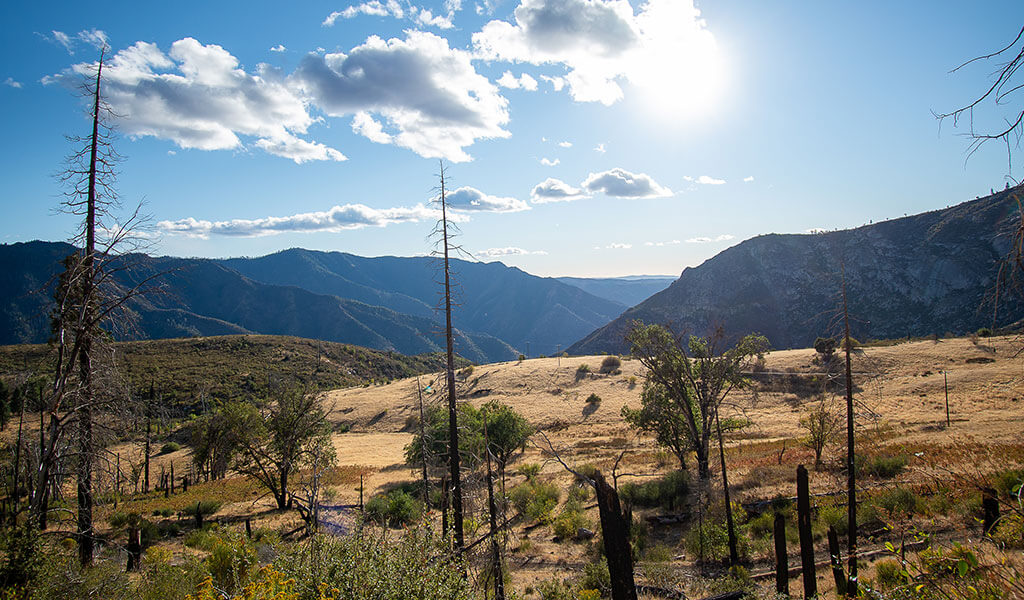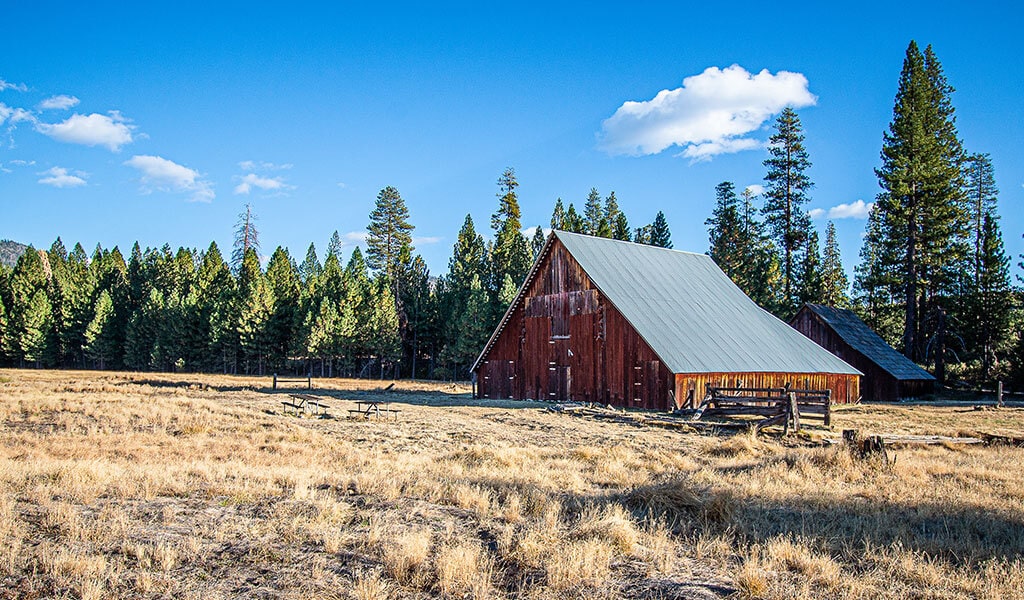Most people hear the name Foresta and scratch their head, conjuring up some vague fairy tale realm. Or for the more utilitarian, maybe they guess it's the latest offering in an AWD crossover vehicle. But what if we told you there's a hidden enclave just a stone's throw from Yosemite Valley, one with hidden waterfalls, an incredibly rich history, and rustic homes boasting improbable views of Half Dome. Worth a listen? Then gather "˜round, ye travelers, for one remarkable tale of Yosemite's many little secrets: Foresta.
Perched at 4,314 feet atop the Merced River Canyon and just seven miles from Yosemite Valley, Foresta is the perfect base camp for families and groups of friends who want a quiet vacation rental with big upside: a pine-cradled mountain meadow, quick access to the Park's biggest attractions and deck-side natural beauty. Take a look at all of the lodging options in Foresta by clicking the link here.
Foresta History

On the final descent into Yosemite Valley via Big Oak Flat Road (highway 120 west), the view opens up to the west as Foresta beckons below with its eye-catching Big Meadow. For millennia the native Miwuk called it "O'pim," making skillful use of this fertile watershed along what is now known as Crane Creek. O'pim proved a plentiful source of sustenance, especially when the heavy snows of the High Sierra drove the Miwuk to lower elevations during winter.
With the formation of Mariposa County in 1850, an increased number of treasure-seeking miners began to explore what was deemed "the Mother of All Counties" due to its vast size and resources. Settlers were soon to follow, and in the early 1870's two determined immigrants from northern Germany "” Peter Mieson and George Meyer "” set up camp at Big Meadow. They grazed cattle and grew hay until 1874 when the Coulterville Road was built as the first stage coach access to the newly "discovered" Yosemite Valley. The two saw opportunity, and branched out by collecting tolls on behalf of the stage company as well as providing meals to curious travelers.
Foresta Fun Fact: Mieson & Meyer allowed Scotsman George Anderson (1839-1884) to build a cabin on their property in exchange for carpentry work. Anderson went on to become the first to summit Half Dome, climbing barefoot and drilling holes where the cables would soon assist other climbers up the massive rock. His cabin was relocated to the Yosemite History Center in Wawona where it can be seen today.
Around 1878, a New Yorker named Thomas A. Rutherford decided to get in on the action. Having run the Cranberry Mine in nearby Merced River Canyon, he homesteaded 160 acres and set up a blacksmith shop and sawmill along Crane Creek. George Meyer "” who never met a job he didn't like "” signed on to work at the shop until Rutherford's passing in 1884, becoming the first to be buried in Big Meadow Cemetery.
Enter James McCauley. A colorful presence in Yosemite since 1870, McCauley famously cut the Four-Mile Trail from the Valley up to Glacier Point (1871), then built the rim-top Mountain House lodge to accommodate the increasing number of hikers who came for the world-class views. Already owning 40 acres in Big Meadow, McCauley purchased Rutherford's homestead for $100 in public auction increasing his holdings to 200 acres.
Foresta Fun Fact #2: McCauley is credited with starting the original Yosemite Firefall, a fiery (and, yes, hard to believe by today's standards) show where burning embers were pushed off the south rim of Yosemite Valley to the ooh's and aww's of tourists. Today, that event is gone, but the natural firefall at Horsetail Fall can be seen each February when conditions are right.
In 1905, the U.S. redrew the boundary of Yosemite National Park leaving Big Meadow as private property within federal land. McCauley passed away in 1911 and the following year the property was purchased by the Foresta Land Company, thus earning its current name. Things were quiet in Foresta for the first half of the 20th century. The Great Depression and two World Wars hindered development until 1951 when electricity was run to Foresta and 74 cabins were built over the next decade. Two fires "” the A-Rock (1990) and Big Meadow (2009) "” caused serious damage but Forestans persevered and today the surrounding landscape has rebounded creating a meadow vista where respectful visitors can find comfortable vacation rentals, many with the golden facade of Half Dome reflecting the sunset a short distance to the east.
Things To Do In Foresta
There are two beautiful yet lightly-visited waterfalls near Foresta that are worth exploring. Foresta Falls is an easy amble (1.8 miles out & back/300 ft elevation gain) along the dirt road that once connected Foresta to El Portal. Park at the end of Foresta Road before the "Road Closed" sign and marvel as the grass-blanketed plateau rolls off the edge into the upper Merced River Canyon. The view is layered and gauzy, especially as sunset nears.
If you're in the mood for a Foresta two-fer, the hike to Little Nellie Falls is a bit longer (5.6 miles out & back/470 ft elevation gain) and has a nice picnic table where visitors can spread out their picnic spreads to the soundtrack of babbling water. Located along the craggy Old Coulterville Road, Little Nellie Falls is just 15-feet but sometimes good things come in small packages. There is no marked trailhead for Little Nellie "” park by the split rail fences where the plaque is located for the historic McCauley & Meyer Barns.
For visitors on a tight schedule, the McCauley & Meyer Barns make for a great photo op/history stop and are the heart and soul of Big Meadow's past. Get out and poke your head inside to see this restored gem and some vintage farm equipment preserved by the park system, or walk across the street the see the pioneer cemetery inaugurated by Rutherford in 1884.
Just as Foresta boasts two lesser-known yet wholly satisfying waterfalls, there are two lesser-known giant Sequoia groves not far from here. Check out the intimate and secluded Merced Grove (3 miles out & back/600 feet elevation gain), or try Tuolumne Grove (2.5 miles out & back/500 feet elevation gain) to stand among these behemoths and feel empowered, naturally.
Foresta Pro Tips
- There are 13 vacation home and cabin rentals located in Foresta. You can search for availability at Yosemite.com in the lodging booking engine. Be sure to select "Foresta" in the location search option.
- Foresta is one of only three areas of private property within Yosemite National Park. Please respect the residents (many of whom have been here for generations) by not blocking driveways and maintaining a quiet presence.
- There are no services in Foresta. Pack in/pack out anything you might need and please follow our Nature Rules! when visiting Yosemite Mariposa County.
- Spring in Foresta features wildflowers and maximum waterfall flow. Late May/early June are the sweet spot, though the falls typically persevere year-round.
- Whether you're into photography or plein air painting, the visual arts are alive & well in Foresta with its signature meadow and views of Yosemite Valley's granite cathedrals.
- Due to its proximity to Yosemite Valley, Foresta vacation rentals are popular so book early...and be sure to bring some local beans for coffee on the deck!
To explore lodging options, things to do and places to eat, visit Yosemite.com, the #1 trip planning site for vacations to Yosemite National Park and historic Mariposa County. To stay up to date, follow @YosemiteNation on social media and subscribe to our newsletter, "The Wanderer". Be sure to subscribe to our YouTube channel for great videos on the people and places of Yosemite Mariposa County.
